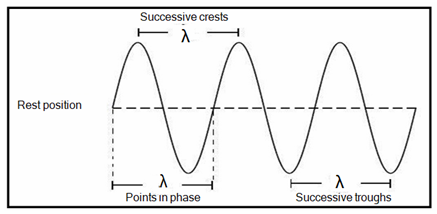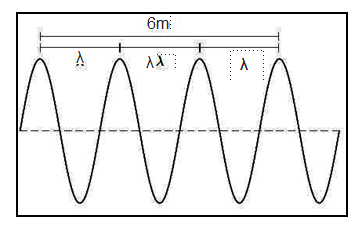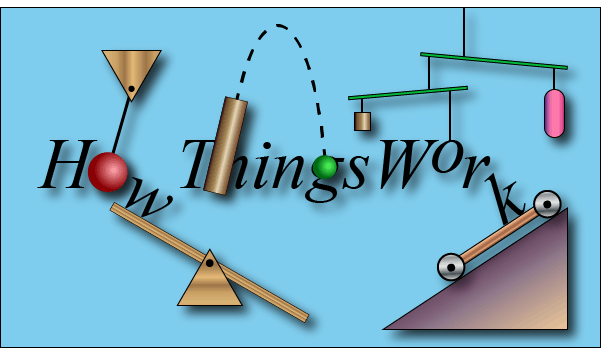2.1 General wave properties
2.1.1 Understand that waves transfer energy without transferring matter properties
2.1.2 Demonstrate wave motion by vibration in ropes and springs and water waves
2.1.3 Distinguish between transverse and longitudinal waves
2.1.4 Use the term wave front
2.1.5 Give the meaning of speed, frequency, wavelength and amplitude
2.1.6 Use the equation v = f λ
2.1.7 Describe how waves can undergo: – reflection at a plane surface – refraction due to a change of speed
2.1.8 Demonstrate reflection and refraction in water waves
2.1.9 Describe how waves can undergo: – diffraction through a narrow gap – diffraction at an edge
2.1.10 Demonstrate diffraction in water waves
2.1.11 Describe how wavelength and gap size affects diffraction through a gap
2.1.12 Describe how wavelength affects diffraction at an edge
https://www.youtube.com/watch?v=eEdbztoFokg
2.1 General wave properties
A wave is an energy disturbance. Waves transfer energy and not matter. Waves transfer energy (disturbance) from one place to another without the movement of the medium or particles in the medium.
A wave is made up of a periodic motion repeated at regular intervals. It is caused by a disturbance in a medium such as water, rope, slinky, air and soon.
We can produce waves by using a rope, a slinky spring or a ripple tank. In each of these cases, we will determine how energy is transferred from one point to another with the wave motion



The source of a wave is a disturbance at one point which causes a vibration or oscillation. This vibrations or oscillations generate waves which travel outward.Sound for example is produced from vibrating objects. The sound reaches our ears because of the vibration so f the air particles from the point of disturbance. Sound waves play a major role in communications today.
Worksheet one
1. The edges or the circumference of a circle produced when disturbing the surface of a still pond of water is called .
|
A. |
wave |
B. |
ripple |
|
C. |
circle |
D. |
energy |
2. What is a wave?
a. When an object vibrates.
b. A wave is a complete motion.
c. The disturbance of water in a pond.
d. A traveling disturbance of some kind.
3. When producing a rope wave, which of the following statements is/are correct?
The rope
a. Travels towards the wall as the wave move up and down.
b. waves travel side ways while the rope moves up and down.
c. waves travel up and down while the rope moves sideways.
d. moves up and down while the rope waves travel towards the wall.
4. Refer to the short passage below to help you answer questions that follows.
A boy decides to do an experiment to investigate how waves behave by using a slinky-spring. While doing the experiment, he noticed that the spring had some regions where the coils are closer together and some regions where the coils are further apart.
a. The region where the coils are closer to get her is called the region of
.
A. vibration B. compression
C. rarefaction D. wave motion
b. The region where the coils are further apart is called the region of .
|
A. |
vibration |
B. |
compression |
|
C. |
rarefaction |
D. |
wave motion |
Some waves, known as mechanical waves,can travel only through a medium. Others called electromagnetic waves can travel either through a medium or through vacuum (empty space)
Waves transfer energy when moving through matter (medium) or space (vacuum). Waves transfer energy from one place to another. You can see how waves carry and transfer energy by the way they crash against the rocks on the sea shores. In water waves, energy is transferred by water ripples. When a wave moves, it may seem that the wave carries matter from place to place as it moves. But that is not what really happens. When waves travel through solids, liquids, and gases, matter is not carried along with it.
Wave energy is the energy transferred by a wave through a medium from one point to another. Waves gain their energy from an initial source.
There are some basic properties of a wave. The properties which are going to be discussed below are for two types of waves and they are:
· A transverse wave
This wave has the motion of the medium perpendicular to the movement of the wave pulse.
· A longitudinal wave
This waves has the motion of the medium parallel to the movement of the wave pulse.
Crests and troughs
Crests are The highest points and the lowest points are called troughs inatransversewave.

Amplitude
The amplitude is the maximum displacement of a particle from its rest position. It is the height of a crest or depth of at rough from rest.

Phase
Any two points are said to be in phase when they move in the same direction and have the same speed and the same displacement from their resting position. Any two successive crests or troughs are always in phase. Displacement refers to the distance from there sting position to that point.
For example, if you look at the diagram below, the point which are in phase are Aand F, B and G, C and H and D and I. These points are in phase because they move in the same direction, have the same speed and have the same displacement from the resting position.

Examples of points on a wave that are in phase
Wave fronts
A wave front is the set or locus of all the points in the same phase. There are three types of wave fronts : plane wave front, spherical wave front, and cylindrical wave front.
Wavelength(λ)
The wave length is the distance between two successive crests, two successive troughs or two points which are in phase.

This distance is called thewavelengthof the wave. The symbol for the wave length is
λ(the Greek letter lambda) and wave length is measured in metres(m).

For longitudinal waves, the wave length is the distance between two successive compressions or rarefactions.

Period
The period (T) is the time taken for one complete wavelength (distance between two successive crests or troughs) to pass a point. It is measured in seconds (s). It is the inverse of frequency measured in seconds.
Frequency
The frequency is the number of waves passing a given pointin1second.TheunitoffrequencyistheHertz(Hz).
The frequency and the period are related to each other. As the period is the timetakenfor1 peak to pass, then the number of peaks passingthepointin1secondis
Frequency = 1/ period. T = 1/f
Example 1.
What is theperiodofawaveoffrequency10Hz?
T = 1/f = 1/10 = 0.1 sec.
Thevelocity(ν) of the wave is the speed that a specific part of the wave passes a point.
Speed = distance/ Time = V = wavelength/ period = λf
NOTE: The sound waves reach our ears because of the vibrating or the oscillating objects. When objects oscillate, the air molecules around the objects also oscillate creating a sound wave to reach our ears
Energy Changes Taking Place in a water Wave
Energy from the sun heats up the air causing wind to blow. The wind blowing on the surface of the ocean transfers the energy on to the ocean surface creating waves. The waves then travel as hore and break on to the beach. This energy now changes to sound and others.

![]()
Flow of Energy Change
Answer the following questions on the spaces provided.
1.
![]()
![]() Consider
the diagram below and answer the questions that follow.
Consider
the diagram below and answer the questions that follow.

Which letter represents the:
a) wavelength?
b) amplitude?
2. Calculate the frequency of rotation of the second hand on a clock.
3. A transverse wave has a frequencyof15Hz.Findtheperiodofthewave.
4. Explain what will happen to the frequency of a wave as its period increases.
5. A science student created transverse waves using a slinky. Where is the energy in the waves from the slinky coming frominthatsituation?
6. During rough weather, the waves in the sea are really high and the crashing waves sounds are louder. Explain why that is so.
Answer: During rough weather the wind is so strong therefore the waves receive a lot more energy from the wind resulting in the increase in amplitude (high waves). The crashing waves sound slouder because it has a lot of energy changed
7. The total distance between4consecutive crests of a transverse wave is6m.

What is the wave length of the wave?
8. Refer tot he diagram of a wave below to answer Question 1.

|
|
Which |
letter represents the: |
|
|
|
(i) |
wave length of the wave? |
|
|
|
(ii) |
amplitude of the wave? |
|
8. Indicate the interval that represents one full wave length.

9. Stan and Anna are conducting a slinky experiment. They are studying the possible effect of several variables upon the speed of a wave in a slinky. Their data table is shown below. Fill in the blanks in the table, analyse the data, and answer the following questions.
|
Medium |
Wavelength |
Frequency |
Speed |
|
Zinc, 1-inchdiametercoils |
1.75m |
2.0Hz |
(a) |
|
Zinc, 1-in.dia.coils |
0.90m |
3.9Hz |
(b) |
|
Copper, 1-in.dia.coils |
1.19m |
2.1Hz |
(c) |
|
Copper, 1-in.dia.coils |
0.60m |
4.2Hz |
(d) |
|
Zinc, 3-in.dia.coils |
0.95m |
2.2Hz |
(e) |
|
Zinc, 3-in.dia.coils |
1.82m |
1.2Hz |
(f) |
10. As the wave length of a wave in a uniform medium increases, what will happen to its
a) speed?
![]()
b) frequency?
![]()
11. On the surface of the sea, the wave length of waves at oneparticulartimewas2.5m.
Calculate the frequencies of the waves at 3 different times when the speeds were:
a) 1.5m/s
![]()
b) 2.8m/s
![]()
c) 3.2m/s
Reflection
When waves hit an object, such as a barrier, they can be reflected:

When waves reflect off a barrier, the angle of reflection, r, is equal to the angle of incidence, i
When waves are reflection:
angle of incidence = angle of reflection
i = r

Refraction
When waves enter a different medium, their speed can change. This effect is called refraction, and it can have two other effects:
- The wavelength of the waves can increase or decrease
- The waves can change direction

When water waves travel from deep areas to shallow areas they slow down
- If the waves slow down the waves will bunch together, causing the wavelength to decrease. The waves will also start to travel closer to the normal
- If the waves speed up then they will spread out, causing the wavelength to increase. The waves will also turn slightly away from the normal.

Diffraction
When waves pass through a narrow gap, the waves spread out. This effect is called diffraction

Diffraction: when a wave passes through a narrow gap, it spreads out.
Diffraction is affected by the size of the gap. Diffraction is more when the gap is less than the wave length

Diffraction also occurs when a wave passes an edge of a barrier

Demonstrating Wave Effects

